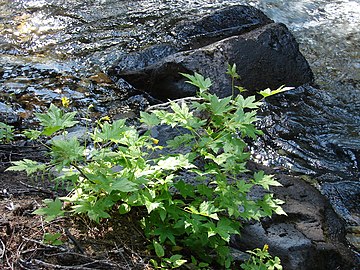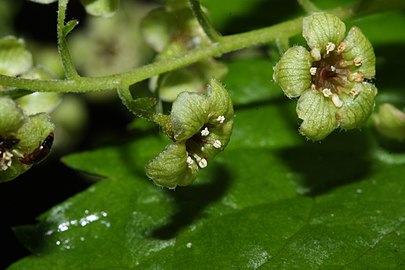Ribes bracteosum: Difference between revisions
added habitat description and citation |
updated bare URLs |
||
| Line 7: | Line 7: | ||
}} |
}} |
||
'''''Ribes bracteosum''''', the '''stink currant''',<ref>{{PLANTS|id=RIBR|taxon=Ribes bracteosum|accessdate=22 October 2015}}</ref> is a species of [[Ribes|currant]] native to western coastal [[North America]] from southeastern [[Alaska]] to [[Mendocino County]] in [[California]].<ref>[http://bonap.net/MapGallery/State/Ribes%20bracteosum.png Biota of North America Program 2014 state-level distribution map]</ref><ref> |
'''''Ribes bracteosum''''', the '''stink currant''',<ref>{{PLANTS|id=RIBR|taxon=Ribes bracteosum|accessdate=22 October 2015}}</ref> is a species of [[Ribes|currant]] native to western coastal [[North America]] from southeastern [[Alaska]] to [[Mendocino County]] in [[California]].<ref>[http://bonap.net/MapGallery/State/Ribes%20bracteosum.png Biota of North America Program 2014 state-level distribution map]</ref><ref>{{Cite web |title=Ribes bracteosum Calflora |url=https://www.calflora.org/app/taxon?crn=7106 |access-date= |website=www.calflora.org}}</ref> |
||
''R. bracteosum'' is a [[deciduous]] [[shrub]], without thorns, growing to {{convert|3|m|ft|-1|abbr=off}} tall. The [[leaves]] are {{convert|5-20|cm|in|0|abbr=off}} across, [[palmate]]ly lobed with 5 or 7 lobes. The [[flower]]s are produced in spring after the leaves emerge, on [[raceme]]s {{convert|15-30|cm|in|0|abbr=on}} long containing 20–40 flowers; each flower is {{convert|5-10|mm|in|frac=16|abbr=off}} in diameter, with five white or greenish-tinged petals. The [[fruit]], born in clusters, is dark blue with a whitish bloom, edible but sometimes unpleasant.<ref name=":0"> |
''R. bracteosum'' is a [[deciduous]] [[shrub]], without thorns, growing to {{convert|3|m|ft|-1|abbr=off}} tall. The [[leaves]] are {{convert|5-20|cm|in|0|abbr=off}} across, [[palmate]]ly lobed with 5 or 7 lobes. The [[flower]]s are produced in spring after the leaves emerge, on [[raceme]]s {{convert|15-30|cm|in|0|abbr=on}} long containing 20–40 flowers; each flower is {{convert|5-10|mm|in|frac=16|abbr=off}} in diameter, with five white or greenish-tinged petals. The [[fruit]], born in clusters, is dark blue with a whitish bloom, edible but sometimes unpleasant.<ref name=":0">{{Cite web |title=Ribes bracteosum in Flora of North America @ efloras.org |url=http://www.efloras.org/florataxon.aspx?flora_id=1&taxon_id=250065808 |access-date=2022-09-06 |website=www.efloras.org}}</ref> Its habitats include stream banks, moist woods, shorelines and thickets.<ref name=":0" /> {{clear|left}} |
||
{{gallery|mode=packed |
{{gallery|mode=packed |
||
Latest revision as of 22:18, 6 September 2022
| Ribes bracteosum | |
|---|---|

| |
| Scientific classification | |
| Kingdom: | Plantae |
| Clade: | Tracheophytes |
| Clade: | Angiosperms |
| Clade: | Eudicots |
| Order: | Saxifragales |
| Family: | Grossulariaceae |
| Genus: | Ribes |
| Species: | R. bracteosum
|
| Binomial name | |
| Ribes bracteosum Dougl. 1832
| |
Ribes bracteosum, the stink currant,[1] is a species of currant native to western coastal North America from southeastern Alaska to Mendocino County in California.[2][3]
R. bracteosum is a deciduous shrub, without thorns, growing to 3 metres (10 feet) tall. The leaves are 5–20 centimetres (2–8 inches) across, palmately lobed with 5 or 7 lobes. The flowers are produced in spring after the leaves emerge, on racemes 15–30 cm (6–12 in) long containing 20–40 flowers; each flower is 5–10 millimetres (3⁄16–3⁄8 inch) in diameter, with five white or greenish-tinged petals. The fruit, born in clusters, is dark blue with a whitish bloom, edible but sometimes unpleasant.[4] Its habitats include stream banks, moist woods, shorelines and thickets.[4]
References[edit]
- ^ USDA, NRCS (n.d.). "Ribes bracteosum". The PLANTS Database (plants.usda.gov). Greensboro, North Carolina: National Plant Data Team. Retrieved 22 October 2015.
- ^ Biota of North America Program 2014 state-level distribution map
- ^ "Ribes bracteosum Calflora". www.calflora.org.
- ^ a b "Ribes bracteosum in Flora of North America @ efloras.org". www.efloras.org. Retrieved 2022-09-06.
External links[edit]
![]() Media related to Ribes bracteosum at Wikimedia Commons
Media related to Ribes bracteosum at Wikimedia Commons





